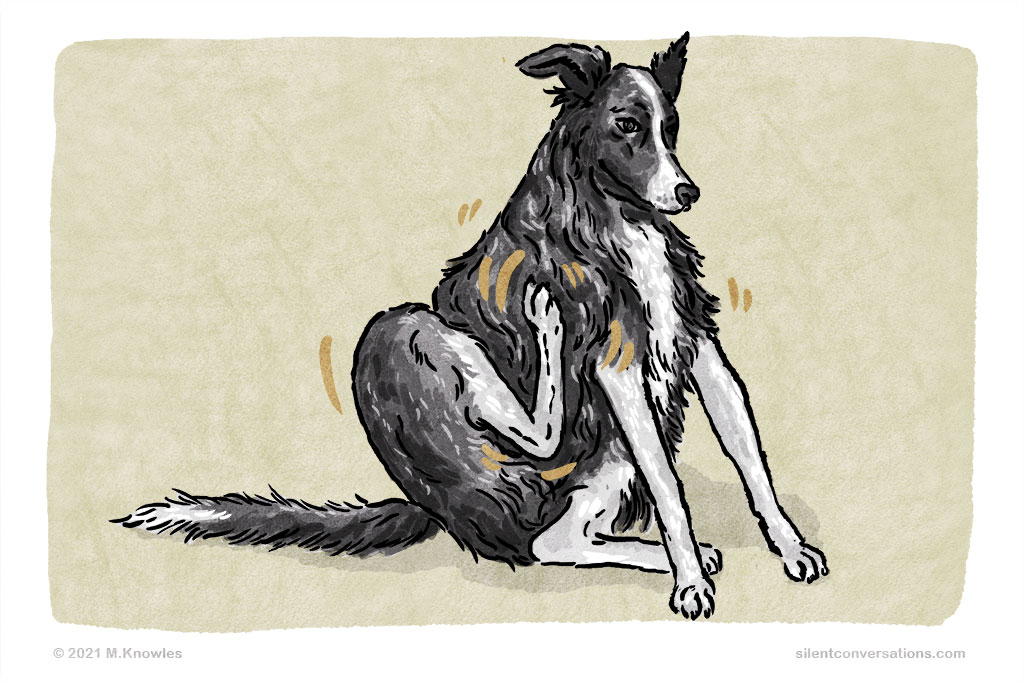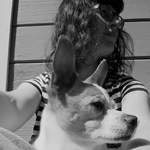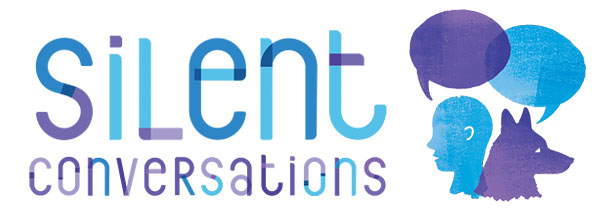
Scratching – Dog Body Language
When a dog scratches his shoulder or neck with his hind leg, this could be due to his having an itch, perhaps caused by skin irritation or allergies. However, it is important to pay attention to how often and in what context the scratching occurs. If it is due to a skin irritation, it is likely the dog will scratch or nibble other parts of the body and not just scratch one area, such as the neck or shoulder, exclusively. Scratching, as body language, can often be overlooked by humans who are not aware this could be an unconscious communication/response that is defined as displacement behaviour.
Displacement behaviours are normal behaviours that occur out of context. They occur when the dog is experiencing conflicting emotions and attempting to deflect stress, uncertainty, anxiety, or frustration. Some of the possible causes of displacement behaviour could be tiredness, stress*, overstimulation, or a response to pressure.
In most cases, these behaviours are a reflection of the dog’s inner state rather than conscious communication, although occasionally the body language could possibly be interpreted as a dog trying to directly communicate discomfort or calm the situation. Therefore, it is vital to observe all body language displayed, circumstances, individuals involved, and environment before offering interpretations.
Here are a few examples of situations where a dog displays scratching as a displacement behaviour:
-
In a puppy class, there are a few dogs and dog guardians moving about practising some cues like ‘sit’ and ‘down’. The guardian of one of the puppies is getting somewhat frustrated, as the puppy does not seem to be responding to the cues. The puppy looks distracted; his movements are fast and seem jittery. He appears to be scanning the environment, does a few lip licks, and seems to be frequently sitting on the floor to scratch his neck with his hind leg. The scratching, along with the rest of the subtle body language, indicates the puppy is overwhelmed with this environment and situation
-
A young dog is being walked on a noisy high-traffic road by her guardian. As they approach the crosswalk, the traffic light turns red for pedestrians, and the dog and guardian have to wait on the sidewalk. The dog is asked to sit, which she does. She does a lip lick, and you can see her ears pivot to the side. Soon, she starts scratching her neck with her hind leg for a prolonged period. She then stands up and starts sniffing the ground. The noise and the frustration of sitting in one spot and not being able to escape this busy corner, cause her to show displacement behaviour because she is feeling uncomfortable with this environment.
-
Three dogs are playing. One dog walks away from the play, which continues between the two other dogs, and she sits a little away from them. The play between the two dogs seems to get noisier and rougher, with the one dog pushing the other over. The dog sitting apart from the others starts scratching herself, with her head turned away from the two playing dogs. In this case, the interpretation could be that the dog is trying to calm the situation down and does not wish to interact further with the other dogs in this manner, or the possible explanation could be displacement behaviour due to the dog feeling overwhelmed with the interaction.
What is meant by stress*?
When I mention stress, this does not necessarily imply negative emotion. I mean stress in the physiological sense. So certain body language signals can mean the dog is feeling some sort of emotional discourse. This discourse could range from positive to negative emotion. Both excitement and fear could have similar effects on the body, with various hormones being released and activating the sympathetic nervous system. The dog may be feeling uncomfortable/fearful or it could also be excited about something. When analyzing stress in body language, it is worth noting the frequency and intensity of the various body language signals.
A few notes to consider when observing dog body language:
Observation before interpretation
Interpretations should be offered only once you have observed the complete interaction and taken note of the wider picture. To offer an unbiased interpretation of the body language, observe and take note of the situation, taking into account the dog’s whole body, the body language signals, and environment first before offering an interpretation. List all the body language you see in the order that it occurs; try to be as descriptive as possible without adding any emotional language. For instance, saying a dog looks happy is not descriptive and would be seen as an interpretation rather than an observation.
You could, however, list what you observe: ears to the side, eyes almond shaped, slight shortening of the eye, mouth open, long lips, tongue out, body moving loosely, body facing side-on, tail wagging at a slow even pace at body level.
From the observation, I could interpret that the dog seems relaxed or comfortable. I still prefer to say relaxed rather than happy, as I feel you will truly never know exactly what the dog may be feeling on the inside emotionally. It is quite likely the dog may be feeling happy, but I prefer to comment on how the dog is behaving in response to the situation rather than presuming internal emotional states.
The importance of viewing body language within context
Interpretations can vary depending on the context. It is possible for certain body language to be used in different contexts and have subtle differences in meaning within those contexts. Individual body language signals should not be observed in isolation; the wider picture should be considered. Take note of what the dog’s body as a whole is saying. Keep in mind each dog is an individual with varying skills and experiences. What may be typical for one individual may not be for another. In order to observe body language in context, consider the following: the situation, body language signals, the body language expressed by all parts of the dog’s body, environment, and individuals involved. It is worth noting how the body language changes with feedback from the environment or the other individuals interacting.

Martha Knowles
Author
My vision is to create a community of dog guardians who share their observations and interpretations of their dogs’ silent conversations. Hopefully, these experiences and stories will provide some insight into dog communication, which is often overlooked by the untrained eye because it is unfamiliar to humans. We are accustomed to communicating mainly with sound, so we are not attuned to the silent subtle gestures and body language used by dogs to communicate. If you take the time to observe, you will start to see these 'silent conversations' going on around you. My dream is for dog communication to become common knowledge with all dog guardians and as many people as possible. Surprisingly, there are still some professionals working in various dog-related careers who are uneducated about dog body language. Greater awareness of how dogs communicate will help to provide better understanding and improve the mutual relationship between dogs and humans. This will promote safer interactions between our two species and hopefully remove some of the expectations placed on dogs within human society. I would like dog guardians to feel empowered with their knowledge of dog communication so that they can be their dogs’ advocates and stand up for themselves and their dogs when it really matters.
